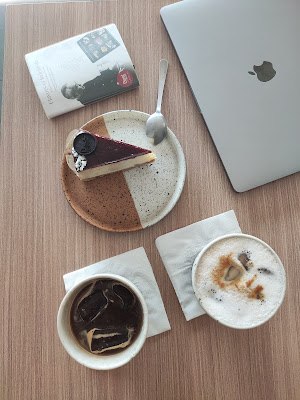Among the places highly recommended by fellow foodies on our Wiskul Cirebon list, is Nasi Jamblang Ibu Fitri. Located across from Grage Mall Cirebon, Ibu Fitri opens her stall quite late, which is around 6 pm, but its popular dishes like Balakutak are usually sold out by early evening.
Perhaps the most traditional looking one compared with others on our Wiskul Cirebon list, Nasi Jamblang Ibu Fitri sets her food stall in a roadside outlet facing the street. During busy nights their customers would take seats outside on the sidewalk, as the seats inside are full, or uncomfortably hot.
Needless to say, as a port city bordering right to the Java Sea, the temperature in Cirebon tends to be on the higher end. However, compared with Jakarta, the heat was not that scorching or humid. The weather tends to be friendlier, and the nights are cool with occasional cool breezes.
How to Order?
First, the staff will prepare a plate for you, then ask how many rice portions you'd want? This is a common practice in Nasi Jamblang sellers in Cirebon as they individually wrapped the rice in Jati (Teak wood) leaves. In the past, the rough jati leaves were believed to preserve the rice better than banana leaves hence suitable for longer storage. The portions are usually very small though, meaning for a normal person it usually requires four parcels of rice.
Additionally, you can also request sambal, which is also wrapped in jati leaves despite smaller ones. Then, you simply point to the dishes that you want and the staff will grab them for you. A single portion is almost always a piece. So if you want more than one, ask for an additional serving.
Here in Nasi Jamblang Ibu Fitri, you pay for the dish after consuming it, and the staff will calculate the price based on what you informed them. Which is rather challenging for big groups or those with hazy leaky memories, not to mention less transparent.
We counted about 20 bowls of individual dishes to choose from, and while that sounds like a lot, there are places that have even more varieties!
What to choose? For the conservative, less adventurous eaters, you will find common options like tahu, tempe, chicken, and beef. For the more adventurous ones, as Cirebon is located very close to the sea, be sure to check out the seafood dishes.
We were aiming for their Balakutak (Cuttlefish) in black ink sauce, which is a rather rare dish to find, especially compared to its more popular sibling Cumi-cumi (Squid). From my upbringing, I recalled treating Balakutak as a special treat, as our mother usually cooked it with its own black ink and a heap of spicy kemangi leaves (Indonesian Basil).
Unfortunately, it was already sold out by the time we came. We also didn't see any Rajungan (Blue swimmer crab) dishes here, which is another one of Cirebon's specials.
There were some other seafood options like Tongkol (Skipjack), salted Jambal Roti (Manyung), and Sate Kerang (Mussels satay). Those in the mood for Hari Raya dishes should not leave out their Semur Ati Sapi (Cow's liver), so smooth and flavorful!
Among local favorites were also Paru (Cow's lung) cooked until crispy, and Sate Kentang (Potatoes satay) with rendang-like seasoning.
In general, the food in Nasi Jamblang Ibu Fitri was flavorful, and the heat from their chili-boosted dishes is rather moderate, compared to its siblings in Jakarta. For the extra kicks, don't forget to ask for their sambal.
Conclusion
Flavor-wise, Nasi Jamblang Ibu Fitri sits highly in our chart. Thick sauces, flavorful spicy seasonings with just moderate hotness, and plenty of options to choose from.
Price-wise it's also very affordable, with a budget of 20-30K for three different dishes.
What we found rather frustrating was the queueless ordering system which triggers our anxiety, especially against ibu-ibu who popped out of nowhere and started ordering despite definitely coming later than us.
Parking on the curb is allowed after dark, and there are also metered ones not too far away that are destined for Nasi Jamblang Mang Dul customers.
Definitely a worthy addition to your Wiskul Cirebon itineraries.
Nasi Jamblang Ibu Fitri
Across Grage Mall, Jl. Cipto Mangunkusumo, Pekiringan, Kesambi, Cirebon City, West Java 45131
Please visit our Wiskul Cirebon recommendations in Google Maps, for ideas of food destinations to visit in Cirebon. (byms)




























Follow Us
Follow Epicurina on your platform of choice